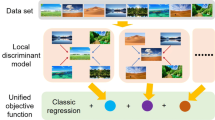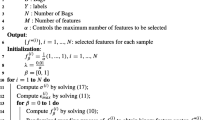Abstract
Multi-instance learning was first proposed by Dietterich et al. (Artificial Intelligence 89(1–2):31–71, 1997) when they were investigating the problem of drug activity prediction. Here, the training set is composed of labeled bags, each of which consists of many unlabeled instances. And the goal of this learning framework is to learn some classifier from the training set for correctly labeling unseen bags. After Dietterich et al., many studies about this new learning framework have been started and many new algorithms have been proposed, for example, DD, EM-DD, Citation-kNN and so on. All of these algorithms are working on the full data set. But as in single-instance learning, different feature in training set has different effect on the training about classifier. In this paper, we will study the problem about feature selection in multi-instance learning. We will extend the data reliability measure and make it select the key feature in multi-instance scenario.



Similar content being viewed by others
References
Dietterich TG, Lathrop RH, Lozano-Pérez T (1997) Solving the multiple-instance problem with axis-parallel rectangles. Artificial Intelligence 89(1–2):31–71
Maron O, Lozano-Pérez T (1998) A framework for multiple-instance learning. In: Jordan MI, Kearns MJ, Solla SA (eds) Neural information processing systems 10. MIT Press, Cambridge, pp 570–576
Zhang Q, Goldman SA, EM-DD (2001) An improved multiple-instance learning technique. Neural Inf Process Syst 14:1073–108
Wang J, Zucker J-D (2000) Solving the multiple-instance problem: a lazy learning approach. In: Proceedings of the 17th international conference on machine learning, San Francisco, CA, pp 1119–1125
Yager RR (1988) On ordered weighted averaging aggregation operators in multicriteria decision making. IEEE Trans Syst Man Cybern 18:183–190
Xu S (2006) Dependent OWA operators. In: Proceedings of modeling decisions for artificial intelligence (MDAI2006), pp 172–178
Boongoen T, Shen Q (2008) Clus-DOWA: a new dependent OWA operator. In: Proceedings IEEE international conference. Fuzzy Sets Syst 1057–1063
Boongoen T, Shen Q (2010) Nearest-neighbor guided evaluation of data reliability and its applications. IEEE Trans Syst Man Cybern B Cybern 40(6):1622–1633
Andrews S, Tsochantaridis I, Hofmann T, Obermayer K (2003) Support vector machines for multiple-instance learning. In: Becker S, Thrun S, Obermayer K (eds) Advances in neural information processing systems 15. MIT Press, Cambridge, pp 561–568
Author information
Authors and Affiliations
Corresponding author
Rights and permissions
About this article
Cite this article
Gan, R., Yin, J. Feature selection in multi-instance learning. Neural Comput & Applic 23, 907–912 (2013). https://doi.org/10.1007/s00521-012-1015-1
Received:
Accepted:
Published:
Issue Date:
DOI: https://doi.org/10.1007/s00521-012-1015-1




